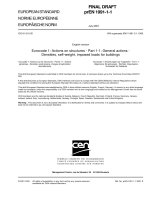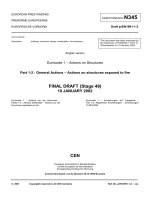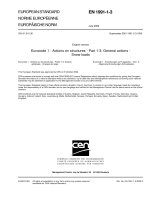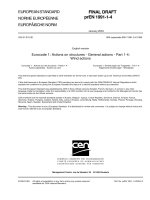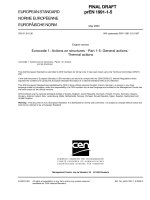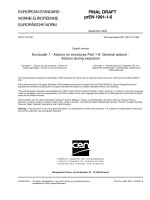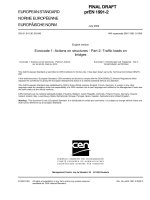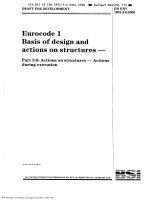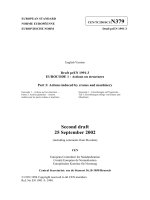Design of masonry structures Eurocode 1 Part 3 - prEN 1991-3-2002
Bạn đang xem bản rút gọn của tài liệu. Xem và tải ngay bản đầy đủ của tài liệu tại đây (405.53 KB, 42 trang )
EUROPEAN STANDARD
CEN/TC250/SC1/
NORME EUROPÉENNE
EUROPÄISCHE NORM
N379
Draft prEN 1991-3
English Version
Draft prEN 1991-3
EUROCODE 1 - Actions on structures
Part 3: Actions induced by cranes and machinery
Eurocode 1 – Einwirkungen auf Tragwerke –
Teil 3: Einwirkungen infolge von Kranen und
Maschinen
Eurocode 1 – Actions sur les structures –
Partie 3: Actions générales – Actions
induites par les ponts roulans et machines
Second draft
25 September 2002
(including comments from Slovakia)
CEN
European Committee for Standardization
Comité Européen de Normalisation
Europäisches Komitee für Normung
Central Secretariat: rue de Stassart 36, B-1050 Brussels
© CEN 1994 Copyright reserved to all CEN members
Ref. No EN 1991-5: 1998
Page 2
prEN 1991-3:2002
CONTENTS
Page
FOREWORD ..............................................................................................................................................4
BACKGROUND OF THE EUROCODE PROGRAMME .......................................................................................4
STATUS AND FIELD OF APPLICATION OF EUROCODES .................................................................................5
NATIONAL STANDARDS IMPLEMENTING EUROCODES ................................................................................6
LINKS BETWEEN EUROCODES AND HARMONISED TECHNICAL SPECIFICATIONS (ENS AND ETAS) FOR
PRODUCTS .................................................................................................................................................6
ADDITIONAL INFORMATION SPECIFIC FOR EN 1991-3................................................................................6
NATIONAL ANNEX FOR EN 1991-3 ............................................................................................................6
SECTION 1 GENERAL.............................................................................................................................8
1.1 SCOPE .................................................................................................................................................8
1.2 NORMATIVE REFERENCES ...................................................................................................................8
1.3 DISTINCTION BETWEEN PRINCIPLES AND APPLICATION RULES ............................................................8
1.4 TERMS AND DEFINITIONS .....................................................................................................................9
1.4.1
Terms and definitions specifically for hoists and cranes on runway beams .......................9
1.4.2
Terms and definitions specifically for actions induced by machines ................................11
1.5 SYMBOLS...........................................................................................................................................12
SECTION 2 ACTIONS INDUCED BY HOISTS AND CRANES ON RUNWAY BEAMS ..............13
2.1
FIELD OF APPLICATION ................................................................................................................13
2.2
CLASSIFICATIONS OF ACTIONS ....................................................................................................13
2.2.1
General .............................................................................................................................13
2.2.2
Variable actions ................................................................................................................13
2.2.3
Accidental actions .............................................................................................................14
2.3
DESIGN SITUATIONS .....................................................................................................................15
2.4
REPRESENTATION OF CRANE ACTIONS .........................................................................................15
2.5
LOAD ARRANGEMENTS ................................................................................................................16
2.5.1
Vertical loads from monorail hoist blocks underslung from runway beams.....................16
2.5.2
Horizontal loads from monorail hoist blocks underslung from runway beams ................16
2.5.3
Vertical loads from overhead travelling cranes................................................................16
2.5.4 Horizontal loads from overhead travelling cranes....................................................................17
2.5.5 Multiple crane action ................................................................................................................19
2.6
VERTICAL CRANE LOADS - CHARACTERISTIC VALUES ..................................................................19
2.7
HORIZONTAL CRANE LOADS - CHARACTERISTIC VALUES .............................................................20
2.7.1
General .............................................................................................................................20
2.7.2
Longitudinal loads HL,i and transverse loads HT,i caused by acceleration and deceleration
of the crane.........................................................................................................................................21
2.7.3
Drive force K ....................................................................................................................22
2.7.4
Horizontal loads HS,i,j,k and the guide force S caused by skewing of the crane ...............23
2.8
TEMPERATURE EFFECTS .............................................................................................................26
2.9
LOADS ON ACCESS WALKWAYS, STAIRS, PLATFORMS AND GUARD RAILS ....................................26
2.9.1
Vertical loads ....................................................................................................................26
2.9.2
Horizontal loads................................................................................................................26
2.10 TEST LOADS................................................................................................................................26
2.11 ACCIDENTAL ACTIONS ................................................................................................................27
2.11.1
Buffer forces HB,1 related to crane movement ...................................................................27
2.11.2
Buffer forces HB,2 related to movements of the crab .........................................................28
2.11.3
Tilting forces .....................................................................................................................28
2.12 FATIGUE LOADS ..........................................................................................................................28
2.12.1
Single crane action ..........................................................................................................28
2.12.2
Stress range effects of multiple wheel or crane actions ...................................................31
Page 3
prEN 1991-3:2002
SECTION 3 ACTIONS INDUCED BY MACHINERY........................................................................32
3.1
FIELD OF APPLICATION .................................................................................................................32
3.2
CLASSIFICATION OF ACTIONS .......................................................................................................32
3.2.1
General .............................................................................................................................32
3.2.2
Permanent actions.............................................................................................................32
3.2.3
Variable actions ................................................................................................................33
3.2.4
Accidental actions .............................................................................................................33
3.3
DESIGN SITUATIONS .....................................................................................................................33
3.4
REPRESENTATION OF ACTIONS ....................................................................................................33
3.4.1
Nature of the loads............................................................................................................33
3.4.2
Modelling of dynamic actions ...........................................................................................34
3.4.3
Modelling of the machinery-structure interaction ............................................................34
3.5
CHARACTERISTIC VALUES ...........................................................................................................35
3.6
SERVICEABILITY CRITERIA ...........................................................................................................37
ANNEX A (INFORMATIVE) .................................................................................................................39
BASIS OF DESIGN – SUPPLEMENTARY CLAUSES TO EN 1990 FOR RUNWAY BEAMS
LOADED BY CRANES ...........................................................................................................................39
A.1
GENERAL.....................................................................................................................................39
A.2
ULTIMATE LIMIT STATES .............................................................................................................39
A.2.1
Combinations of actions....................................................................................................39
A.2.2
Partial factors ...................................................................................................................40
A.2.3
Ρ factors for crane loads ...................................................................................................41
A.3
SERVICEABILITY LIMIT STATES ....................................................................................................41
A.3.1
Combinations of actions....................................................................................................41
A.3.2
Partial factors ...................................................................................................................41
A.3.3
Ρ factors for crane actions ................................................................................................41
A.4
FATIGUE ......................................................................................................................................41
ANNEX B (INFORMATIVE) ................................................................................................................42
GUIDANCE FOR CRANE CLASSIFICATION FOR FATIGUE.......................................................42
Page 4
prEN 1991-3:2002
Foreword
This European Standard has been prepared by Technical Committee CEN/TC 250
« Structural Eurocodes », the secretariat of which is held by BSI.
CEN/TC 250 is responsible for all Structural Eurocodes.
This document is currently submitted to the Formal Vote.
This European Standard supersedes ENV 1991-5:1998.
The annexes A and B are informative.
Background of the Eurocode programme
In 1975, the Commission of the European Community decided on an action programme
in the field of construction, based on article 95 of the Treaty. The objective of the
programme was the elimination of technical obstacles to trade and the harmonisation of
technical specifications.
Within this action programme, the Commission took the initiative to establish a set of
harmonised technical rules for the design of construction works which, in a first stage,
would serve as an alternative to the national rules in force in the Member States and,
ultimately, would replace them.
For fifteen years, the Commission, with the help of a Steering Committee with
Representatives of Member States, conducted the development of the Eurocodes
programme, which led to the first generation of European codes in the 1980s.
In 1989, the Commission and the Member States of the EU and EFTA decided, on the
basis of an agreement1 between the Commission and CEN, to transfer the preparation
and the publication of the Eurocodes to the CEN through a series of Mandates, in order
to provide them with a future status of European Standard (EN). This links de facto the
Eurocodes with the provisions of all the Council’s Directives and/or Commission’s
Decisions dealing with European standards (e.g. the Council Directive 89/106/EEC on
construction products - CPD - and Council Directives 93/37/EEC, 92/50/EEC and
89/440/EEC on public works and services and equivalent EFTA Directives initiated in
pursuit of setting up the internal market).
The Structural Eurocode programme comprises the following standards generally
consisting of a number of Parts:
EN 1990
EN 1991
EN 1992
EN 1993
1
Eurocode :
Eurocode 1:
Eurocode 2:
Eurocode 3:
Basis of Structural Design
Actions on structures
Design of concrete structures
Design of steel structures
Agreement between the Commission of the European Communities and the European Committee for Standardisation (CEN)
concerning the work on EUROCODES for the design of building and civil engineering works (BC/CEN/03/89).
Page 5
prEN 1991-3:2002
EN 1994
EN 1995
EN 1996
EN 1997
EN 1998
EN 1999
Eurocode 4:
Eurocode 5:
Eurocode 6:
Eurocode 7:
Eurocode 8:
Eurocode 9:
Design of composite steel and concrete structures
Design of timber structures
Design of masonry structures
Geotechnical design
Design of structures for earthquake resistance
Design of aluminium structures
Eurocode standards recognise the responsibility of regulatory authorities in each
Member State and have safeguarded their right to determine values related to regulatory
safety matters at national level where these continue to vary from State to State.
Status and field of application of Eurocodes
The Member States of the EU and EFTA recognise that Eurocodes serve as reference
documents for the following purposes:
as a means to prove compliance of building and civil engineering works with the
essential requirements of Council Directive 89/106/EEC, particularly Essential
Requirement N°1 – Mechanical resistance and stability – and Essential Requirement
N°2 – Safety in case of fire ;
as a basis for specifying contracts for construction works and related engineering
services ;
as a framework for drawing up harmonised technical specifications for construction
products (ENs and ETAs)
The Eurocodes, as far as they concern the construction works themselves, have a direct
relationship with the Interpretative Documents2 referred to in Article 12 of the CPD,
although they are of a different nature from harmonised product standards3. Therefore,
technical aspects arising from the Eurocodes work need to be adequately considered by
CEN Technical Committees and/or EOTA Working Groups working on product
standards with a view to achieving full compatibility of these technical specifications
with the Eurocodes.
The Eurocode standards provide common structural design rules for everyday use for
the design of whole structures and component products of both a traditional and an
innovative nature. Unusual forms of construction or design conditions are not
specifically covered and additional expert consideration will be required by the designer
in such cases.
2
According to Art. 3.3 of the CPD, the essential requirements (ERs) shall be given concrete form in interpretative documents for
the creation of the necessary links between the essential requirements and the mandates for harmonised ENs and ETAGs/ETAs.
3
According to Art. 12 of the CPD the interpretative documents shall :
a) give concrete form to the essential requirements by harmonising the terminology and the technical bases and indicating classes or levels
for each requirement where necessary ;
b) indicate methods of correlating these classes or levels of requirement with the technical specifications, e.g. methods of calculation and of
proof, technical rules for project design, etc. ;
c) serve as a reference for the establishment of harmonised standards and guidelines for European technical approvals.
The Eurocodes, de facto, play a similar role in the field of the ER 1 and a part of ER 2.
Page 6
prEN 1991-3:2002
National Standards implementing Eurocodes
The National Standards implementing Eurocodes will comprise the full text of the
Eurocode (including any annexes), as published by CEN, which may be preceded by a
National title page and National foreword, and may be followed by a National annex.
The National annex may only contain information on those parameters which are left
open in the Eurocode for national choice, known as Nationally Determined Parameters,
to be used for the design of buildings and civil engineering works to be constructed in
the country concerned, i.e. :
values and/or classes where alternatives are given in the Eurocode,
values to be used where a symbol only is given in the Eurocode,
country specific data (geographical, climatic, etc.), e.g. snow map,
the procedure to be used where alternative procedures are given in the Eurocode,
decisions on the application of informative annexes,
references to non-contradictory complementary information to assist the user to apply
the Eurocode.
Links between Eurocodes and harmonised technical specifications (ENs and
ETAs) for products
There is a need for consistency between the harmonised technical specifications for
construction products and the technical rules for works4. Furthermore, all the
information accompanying the CE Marking of the construction products which refer to
Eurocodes should clearly mention which Nationally Determined Parameters have been
taken into account.
Additional information specific for EN 1991-3
EN 1991-3 gives design guidance and actions for the structural design of buildings and
civil engineering works, including the following aspects:
actions induced by cranes and
actions induced by machinery.
EN 1991-3 is intended for clients, designers, contractors and public authorities.
EN 1991-3 is intended to be used with EN 1990, the other Parts of EN 1991 and EN
1992 to EN 1999 for the design of structures.
National annex for EN 1991-3
This standard has been drafted on the assumption that it will be complemented by a
National annex to enable it to be used for the design of buildings and civil engineering
works to be constructed in the relevant country.
The National annex for EN 1991-3 should include:
4
see Art.3.3 and Art.12 of the CPD, as well as clauses 4.2, 4.3.1, 4.3.2 and 5.2 of ID 1.
Page 7
prEN 1991-3:2002
National choice allowed by notes, in relation to reliability format and values of the
particular actions only when a range is provided; National choice is allowed in this
document through :
Selection of procedures from amongst the parallel procedures defined, when this is
allowed by a note ;
Reference to non-contradicting complementary information provided by National
Regulations and Requirements and additional publications which supplement the
Eurocodes.
Page 8
prEN 1991-3:2002
Section 1 General
1.1 Scope
(1) Part 3 of EN 1991 specifies imposed loads (models and representative values)
associated with cranes on runway beams and stationary machines which include, when
relevant, dynamic effects and braking, acceleration and accidental forces.
(2) Section 1 defines common definitions and notations.
(3) Section 2 specifies actions induced by cranes on runways.
(4) Section 3 specifies actions induced by stationary machines.
1.2 Normative References
This European Standard incorporates by dated or undated reference provisions from
other publications. These normative references are cited at the appropriate places in the
text and the publications are listed hereafter. For dated references, subsequent
amendments to, or revisions of, any of these publications apply to this European Standard only when incorporated in it by amendment or revision. For undated references the
latest edition of the publication referred to applies (including amendments).
ISO 3898 Basis of design of structures - Notations. General symbols
ISO 2394 General principles on reliability for structures
ISO 8930 General principles on reliability for structures. List of equivalent terms
NOTE 1 The Eurocodes were published as European Prestandards. The following European
Standards which are published or in preparation are cited in normative clauses :
EN 1990
EN 13001-1
EN 13001-2
Eurocode : Basis of Structural Design
Crane safety –Part 1 General principles and requirements
Crane safety –Part 2 Load effects
1.3 Distinction between Principles and Application Rules
(1) Depending on the character of the individual clauses, distinction is made in this Part
between Principles and Application Rules.
(2) The Principles comprise:
-
general statements and definitions for which there is no alternative, as well as
requirements and analytical models for which no alternative is permitted unless
specifically stated.
(3) The Principles are identified by the letter P following the paragraph number.
Page 9
prEN 1991-3:2002
(4) The Application Rules are generally recognised rules which comply with the
Principles and satisfy their requirements.
(5) It is permissible to use alternative design rules different from the Application Rules
given in EN 1991-3 for works, provided that it is shown that the alternative rules accord
with the relevant Principles and are at least equivalent with regard to the structural
safety, serviceability and durability which would be expected when using the Eurocodes.
NOTE If an alternative design rule is substituted for an Application Rule, the resulting design
cannot be claimed to be wholly in accordance with EN 1991-3 although the design will remain in
accordance with the Principles of EN 1991-3. When EN 1991-3 is used in respect of a property
listed in an Annex Z of a product standard or an ETAG, the use of an alternative design rule may
not be acceptable for CE marking.
(6) In this Part the Application Rules are identified by a number in brackets, e.g. as this
clause.
1.4 Terms and definitions
For the purposes of this European Standard, the terms and definitions given in ISO
2394, ISO 3898, ISO 8930 and the following apply. Additionally for the purposes of this
standard a basic list of terms and definitions is provided in EN 1990, 1.5.
1.4.1 Terms and definitions specifically for hoists and cranes on runway beams
1.4.1.1 Dynamic factor: Factor that that represents the ratio of the dynamic response to
the static one. covers dynamic effects as from vibrational excitations, impact etc.
1.4.1.2 Selfweight QC of the crane:Selfweight of all fixed and movable elements
including the mechanical and electrical equipment of a crane structure, however without
the lifting attachment and a portion of the suspended hoist ropes or chains moved by the
crane structure, see 1.4.1.3.
1.4.1.3 Hoistload QH: It includes the masses of the payload, the lifting attachment and a
portion of the suspended hoist ropes or chains moved by the crane structure, see Figure
1.1.
Page 10
prEN 1991-3:2002
Figure 1.1: Definition of the hoistload and the selfweight of a crane
1.4.1.4 Crab: Part of an overhead travelling crane that incorporates a hoist and is able to
travel on rails on the top of the crane bridge.
1.4.1.5 Crane bridge: Part of an overhead travelling crane that spans between the crane
runway beams and supports the crab.
1.4.1.6 Guidance means: System used to keep a crane aligned on a runway, through
horizontal reactions between the crane and the runway beams. The guidance means can
consist of flanges on the crane wheels or a separate system of guide rollers operating on
the side of the crane rails or the side of the runway beams.
1.4.1.7 Hoist: A machine for lifting loads.
1.4.1.8 Hoist block: An underslung trolley that incorporates a hoist and is able to travel
on the bottom flange of a beam, either on a fixed runway (as shown in Figure 1.2) or
under the bridge of an overhead travelling crane (as shown in Figures 1.3 and 1.4).
1.4.1.9 Overhead travelling crane: A machine for lifting and moving loads, that moves
on wheels along overhead crane runway beams. It incorporates one or more hoists
mounted on crabs or underslung trolleys.
1.4.1.10 Runway beam for hoist block: Crane runway beam provided to support a
monorail hoist block that is able to travel on its bottom flange, see Figure 1.2.
Figure 1.2: Runway beam with hoist block
Page 11
prEN 1991-3:2002
1.4.1.11 Underslung crane: Overhead travelling crane that is supported on the bottom
flanges of the crane runway beams, see Figure 1.3.
Figure 1.3: Underslung crane with hoist block
1.4.1.12 Top-mounted crane: Overhead travelling crane that is supported on the top of
the crane runway beam. It usually travels on rails, but sometimes travels directly on the
top of the beams, see Figure 1.4.
Figure 1.4: Top mounted crane with hoist block
1.4.2 Terms and definitions specifically for actions induced by machines
1.4.2.1 Natural frequency: The frequency of free vibration on a system. For a multiple
degree-of-freedom system, the natural frequencies are the frequencies of the normal
modes of vibrations. The dynamic property of an elastic body or system by which it
oscillates repeatedly from a fixed reference point when the external force is removed.
1.4.2.2 Free vibration: The vibration of a system that occurs in the absence of forced
vibration. Vibration process of a system excited initially, which may be in the form of
initial displacement or velocity, but no more time-varying force acting on it.
1.4.2.3 Forced vibration: The vibration of a system if the response is imposed by the
excitation.Vibration process of a system which is caused by external time-varying loads
acting on it.
1.4.2.4 Damping: The dissipation of energy with time or distance. Damping is
dissipation of energy in a vibrating system.
1.4.2.5 Resonance: Resonance of a system in forced harmonic vibration exists when
any change, however small, in the frequency of excitation causes a decrease in the
response of the system.
Resonance of a system in forced vibration is a condition when any change, however
small, in the frequency of excitation causes a decrease in the response of the system.
Page 12
prEN 1991-3:2002
1.4.2.6 Mode of vibration: In a system undergoing vibration, a mode of vibration is a
characteristic pattern assumed by the system in which the motion of every particle is
simple harmonic with the same frequency. Two or more modes may exist concurrently
in a multiple -–degree of freedom system. A normal (natural) mode of vibration is a
mode of vibration that is uncoupled from other modes of vibration of a system.
1.5 Symbols
(1) For the purposes of this European standard, the following symbols apply.
NOTE The notation used is based on ISO 3898: 1997.
(2) A basic list of symbols is provided in EN 1990 clause 1.6 and the additional
notations below are specific to this part of EN 1991.
Latin upper case letters
Fk
Fw
HB
HL
HS
HT
HTA
K
Qc
Qh
QT
characteristic value of a crane action
Forces caused by in service wind
buffer force
longitudinal loads caused by acceleration and deceleration
horizontal loads caused by skewing
transverse loads caused by acceleration and deceleration
tilting force
drive force
selfweight of the crane
hoistload
test load
Latin lower case letters
h
kQ
Ρ
mc
mw
n
nr
distance between the instantaneous slide pole and means of guidance
load spectrum factor
span of the crane bridge
mass of the crane
number of single wheel drives
number of wheel pair
number of runway beams
Greek lower case letters
∀
8
:
νi
νfat
skewing angle
damage equivalent factor
friction factor
dynamic factor
damage equivalent dynamic impact factor
Page 13
prEN 1991-3:2002
Section 2
Actions induced by hoists and cranes on runway beams
2.1 Field of application
(1) This section specifies actions (models and representative values) induced by:
– underslung trolleys on runways, see 2.5.1 and 2.5.2;
– overhead travelling cranes, see 2.5.3 and 2.5.4.
(2) The methods prescribed in this section are compatible with the provisions in EN
13001-1 and EN 13001-2, to facilitate the exchange of data with crane suppliers.
2.2 Classifications of actions
2.2.1 General
(1)P Actions induced by cranes are classified as variable and accidental actions which
are represented by various models.
2.2.2 Variable actions
(1) For normal service conditions variable crane actions result from variation in time
and location. They include gravity loads including hoistloads, inertial forces caused by
acceleration/deceleration and by skewing and other dynamic effects.
(2) The variable crane actions should be separated in variable vertical crane actions
caused by the selfweight of the crane and the hoist load and in variable horizontal crane
actions caused by acceleration or deceleration or by skewing or other dynamic effects.
(3) The various representative values of variable crane actions are characteristic values
composed of a static and a dynamic component.
(4) Dynamic components induced by vibration due to inertial and damping forces are in
general accounted by dynamic factors ϕ to be applied to the static action values.
different loads due to masses and inertial forces are in general given in terms of dynamic
factors ϕi to be applied to the static load values.
Fk = ϕi F
(2.1)
where:
Fk is the characteristic value of a crane action;
ϕi is the dynamic factor, see Table 2.1;
F is the static component of a crane action.
(5) The various dynamic factors and their application are listed in Table 2.1.
(6) The simultaneity of the crane load components may be taken into account by
considering groups of loads as identified in Table 2.2. Each of these groups of loads
Page 14
prEN 1991-3:2002
should be considered as defining one characteristic crane action for the combination
with non-crane loads.
NOTE: The grouping provides that only one horizontal crane action is considered at a time.
2.2.3 Accidental actions
(1) Cranes may generate accidental actions due to collision with buffers (buffer forces)
or collision of lifting attachments with obstacles (tilting forces). These actions should be
considered for the structural design where appropriate protection is not provided.
(2) Accidental actions described in 2.11 refer to common situations. They are
represented by various load models defining design values (i.e. to be used with (A = 1,0)
in the form of equivalent static loads.
(3) The simultaneity of accidental crane load components may be taken into account by
considering groups of loads as identified in Table 2.2. Each of these groups of loads
defines one crane action for the combination of non-crane loads.
Table 2.1: Dynamic factors νi
Dynamic
factors
Effects to be considered
ν1
–vibrational excitation of the crane structure due to
lifting the hoist load off the ground
–dynamic effects of transferring the hoistload from the
ground to the crane
ν2
or
ν3
selfweight of
the crane
hoistload
–dynamic effect of sudden release of the payload if for
example grabs or magnets are used
ν4
–dynamic effects induced when crane is travelling on
rail tracks or runways
ν5
–dynamic effects caused by drive forces
ν6
–when a test load is moved by the drives in the way
the crane is used
–considers the dynamic elastic effects of impact on
buffers
ν7
To be applied to
selfweight of
the crane and
hoistload
drive forces
test load
buffer loads
Page 15
prEN 1991-3:2002
Table 2.2: Groups of loads and dynamic factors to be
considered as one characteristic crane action
Groups of loads
Symbol
Section
ULS
SLS
Accidental
1
2
3
4
5
6
7
8
9
10
1 Selfweight of crane
QC
2.6
ν1
ν1
1
ν4
ν4
ν4
1
ν1
1
1
2 Hoist load
QH
2.6
ν2
ν3
-
ν4
ν4
ν4
01)
-
1
1
HL, HT
2.7
ν5
ν5
ν5
ν5
-
-
-
ν5
-
-
4 Skewing of crane bridge
HS
2.7
-
-
-
-
1
-
-
-
-
-
5 Acceleration or braking of
crab or hoist block
HT3
2.7
-
-
-
-
-
1
-
-
-
-
6 In service wind
FW*
Annex A
1
1
1
1
1
-
-
1
-
-
7 Test load
QT
2.10
-
-
-
-
-
-
-
ν6
-
-
8 Buffer force
HB
2.11
-
-
-
-
-
-
-
-
ν7
-
9 Tilting force
HTA
2.11
-
-
-
-
-
-
-
-
-
1
3 Acceleration of crane
bridge
1)
0 is the part of the hoist load that remains when the payload is removed, but is not included in the
selfweight of the crane.
2.3 Design situations
(1)P The relevant actions induced by cranes shall be determined for each design
situation identified in accordance with EN 1990.
(2)P Selected design situations shall be considered and critical load cases identified. For
each critical load case the design values of the effects of actions in combination shall be
determined.
(3) Multiple crane actions from several cranes are given in 2.5.5.
(4) Combination rules for crane actions with other actions are given in annex A.
(5) For the fatigue verification fatigue load models are given in 2.12.
(6) In case tests are performed with cranes on the supporting structures for the
serviceability limit state verification, the test loading model of the crane is specified in
2.10.
2.4 Representation of crane actions
(1) The actions to be considered should be those exerted on the crane runway beams by
the wheels of the cranes and possibly by guide rollers or other guidance means.
Page 16
prEN 1991-3:2002
(2) Horizontal forces on crane supporting structures arising from horizontal movement
of monorail hoist cranes and crane hoists should be determined from 2.5.2, 2.5.4 and
2.7.
2.5 Load arrangements
2.5.1 Vertical loads from monorail hoist blocks underslung from runway beams
(1) For normal service conditions, the vertical load should be taken as composed of the
selfweight of the hoist block, the hoistload and the dynamic factor, see Table 2.1 and
Table 2.2.
2.5.2 Horizontal loads from monorail hoist blocks underslung from runway beams
(1) In the case of fixed runway beams for monorail underslung trolleys, in the absence
of a more accurate value, the horizontal loads should be taken as 5% of the maximum
vertical wheel load, neglecting the dynamic factor.
(2) This also applies to horizontal loads in the case of swinging suspended runway
beams.
2.5.3 Vertical loads from overhead travelling cranes
(1) The relevant vertical wheel loads from a crane on a runway beam, should be
determined by considering the load arrangements illustrated in Figure 2.5, using the
characteristic values given in 2.6.
a) Load arrangement of the loaded crane to obtain the maximum loading on the runway beam
b) Load arrangement of the unloaded crane to obtain the minimum loading on the runway beam
Figure 2.5: Load arrangements to obtain the relevant vertical
actions to the runway beams
where:
Page 17
prEN 1991-3:2002
Qr,max
Qrmax
ΕQr,max
ΕQrmax
Qr,min
Qrmin
ΕQr,min
ΕQrmin
Qr,nom
is the maximum load per wheel of the loaded crane
is the accompanying load per wheel of the loaded crane
is the sum of the maximum loads Qr,max per runway of the loaded crane
is the accompanying sum of the maximum loads Qrmax per runway of the
loaded crane
is the minimum load per wheel of the unloaded crane
is the accompanying load per wheel of the unloaded crane
is the sum of the minimum loads Qr,min per runway of the unloaded crane
is the accompanying sum of the minimum loads Qrmin per runway of the
unloaded crane
is the nominal hoistload
(2) The eccentricity of application e of a wheel load Qr to a rail should be taken as equal
to a quarter of the width of the rail head br, see Figure 2.6.
Figure 2.6: Eccentricity of the load introduction
2.5.4 Horizontal loads from overhead travelling cranes
(1) The following types of horizontal loads from overhead travelling cranes should be
taken into account:
a) horizontal loads caused by acceleration or deceleration of the crane in relation to
its movement along the runway beam, see 2.7.2;
b) horizontal loads caused by acceleration or deceleration of the crab or underslung
trolley in relation to its movement along across the crane bridge, see 2.7.5;
c) horizontal loads caused by skewing of the crane in relation to its movement along
the runway beam, see 2.7.4;
d) buffer forces related to crane movement, see 2.11.1;
e) buffer forces related to movement of the crab or underslung trolley, see 2.11.2.
(2) Unless otherwise specified, only one of the five types of horizontal load (a) to (e)
listed in (1) should be included in the same group of simultaneous crane load
components, see Table 2.2.
Page 18
prEN 1991-3:2002
(3) For underslung cranes the horizontal loads at the wheel contact surface should be
taken as at least 10% of the maximum vertical wheel load neglecting the dynamic
component unless a more accurate value is justified.
(4) Unless otherwise specified, the longitudinal horizontal wheel forces HL,i and the
transverse horizontal wheel forces HT,i caused by acceleration and deceleration of
masses of the crane or the crab etc., should be applied as given in Figure 2.7. The
characteristic values of these forces are given in 2.7.2.
R ail i = 1
R ail i = 2
H T ,1
H T ,2
H T ,1
H
H
H
L,1
T ,2
L,2
Figure 2.7: Load arrangement of longitudinal and transverse horizontal wheel
forces caused by acceleration and deceleration
NOTE: These forces do not include the effects of oblique hoisting due to misalignment of load and
crab because in general oblique hoisting is forbidden. Any effects of unavoidable small values of
oblique hoisting are included in the inertial forces.
(5) The longitudinal and transverse horizontal wheel forces HS,i,j,k and the guide force S
caused by skewing may occur at the guidance means of cranes or trolleys while they are
travelling or traversing in steady state motion, see Figure 2.8. These loads are induced
by guidance reactions which force the wheel to deviate from their free-rolling natural
travelling or traverse direction. The characteristic values are given in 2.7.4.
R ail i = 1
D irecto n o f m o tio n
Raili= 1
R ail i = 2
H S ,1 ,2 ,T
H
S ,1 ,2 ,L
Raili= 2
α
α
H S ,1 ,1 ,T
D irecton of m otion
S
W h eel p air j = 1
H
W h eel p air j = 2
H S ,2 ,2 ,T
S ,2 ,1 ,T
H S,1,1,T
S
W heelpair j= 1
H S,2,1,T
W heelpair j= 2
G u id e m ean s
H
a) with separate guidance means
S ,2 ,2 ,L
b) with guidance by means of wheel flanges
NOTE: The direction of the horizontal loads depends on the type of guidance means, the direction of
motion and on the type of wheel drive.
Figure 2.8: Load arrangement of longitudinal and transverse horizontal wheel
forces caused by skewing
Page 19
prEN 1991-3:2002
2.5.5 Multiple crane action
(1)P Cranes that are required to operate together shall be treated as a single crane action.
(2) If several cranes are operating independently, the maximum number of cranes taken
into account as acting simultaneously should be as given in Table 2.3.
Table 2.3: Maximum number of cranes to be considered in
the most unfavourable position
Cranes to each runway
Cranes in each shop bay
Cranes in multi – bay
buildings
Vertical crane action
3
4
4
2
Horizontal crane action
2
2
2
2
2.6 Vertical crane loads - characteristic values
(1) The characteristic values of the vertical loads from cranes on crane supporting
structures should be determined as indicated in Table 2.2.
(2)P For the selfweight of the crane and the hoistload, the nominal values specified by
the crane supplier shall be taken as characteristic values of the vertical loads.
Page 20
prEN 1991-3:2002
Table 2.4: Dynamic factors νi for vertical loads
ν1
0,9 < ν1 < 1,1
The two values 1,1 and 0,9 reflect the upper and lower values of
the vibrational pulses.
ν2
ν3
ν2 = ν2,min + 82 vh
vh - steady hoisting speed in [m/s]
ν2,min and 82 see table 2.5
ϕ3 = 1 -
∆m
(1 + ß 3 )
m
where
)m
m
83 = 0,5
83 = 1,0
ν4
released or dropped part of the load
total hoisting load
for cranes equipped with grabs or similar slowrelease devices
for cranes equipped with magnets or similar rapidrelease devices
ν4 = 1,0
provided that the tolerances for rail tracks as specified in ENV 19936 are observed.
(3) If the dynamic factors ν1, ν2, ν3 and ν4 as specified in Table 2.1 are not included in
the specifications of the crane supplier the indications in Table 2.4 may be used.
(4) For in-service wind reference should be made to annex A.
Table 2.5: Values of β2 and ν2,min
Hoisting class
of appliance
β2
ν2,min
HC1
HC2
HC3
HC4
0,17
0,34
0,51
0,68
1,05
1,10
1,15
1,20
NOTE: Cranes are assigned to Hoisting Classes HC1 to HC4 to
allow for the dynamic effects of transferring the load from the
ground to the crane. The selection depends on the particular type of
crane, see recommendation in annex B.
2.7 Horizontal crane loads - characteristic values
2.7.1 General
(1)P For the acceleration and the skewing effects, the nominal values specified by the
crane supplier shall be taken as characteristic values of the horizontal loads.
Page 21
prEN 1991-3:2002
(2) The characteristic values of the horizontal loads may be specified by the crane
supplier or be determined using 2.7.2 to 2.7.5.
2.7.2 Longitudinal loads HL,i and transverse loads HT,i caused by acceleration and
deceleration of the crane
(1) The longitudinal loads HL,i caused by acceleration and deceleration of crane
structures result from the drive force at the contact surface between the rail and the
driven wheel, see Figure 2.9.
(2) The longitudinal loads HL,i applied to a runway beam may be calculated as follows:
H L,i = ϕ 5 K
1
nr
(2.2)
where:
nr
K
ν5
i
is the number of runway beams;
is the drive force according to 2.7.3;
is the dynamic factor, see Table 2.6;
is the integer to identify the runway beam (i = 1,2).
R ail i = 1
H
L,1
R ail i = 2
H
L,2
Figure 2.9: Longitudinal horizontal loads HL,i
(3) The moment M resulting from the drive force which should be applied at the centre
of mass is equilibrated by transverse horizontal loads HT,1 and HT,2, see Figure 2.10. The
horizontal loads may be obtained as follows:
H T,1 = ϕ 5 ξ 2
H T,2 = ϕ 5 ξ 1
where:
ξ1 =
M
a
M
a
∑ Qr,max
∑ Qr
>2
= 1 - >1 ;
Ε Qr
= Ε Qr,max + Ε Qrmax;
Ε Qr,max see Figure 2.1;
Ε Qrmax see Figure 2.1;
a
is the spacing of the guide roller or the wheel flanges;
(2.3)
(2.4)
Page 22
prEN 1991-3:2002
M
Ρs
Ρ
ν5
K
= K Ρs ;
= (>1 - 0,5) Ρ ;
is the span length of the crane bridge;
is the dynamic factor, see Table 2.6;
is the drive force, see 2.7.3.
R ail i = 1
R ail i = 2
H T ,2
H T ,1
M
S
a
H T ,1
H
T ,2
ls
K
K = K 1+
1
ξl
K
K2
2
ξl
1
2
l
Figure 2.10: Definition of the transverse loads HT,i
(4) For curved runway beams the resulting centrifugal force should be multiplied by the
dynamic factor ν5.
(5) If the dynamic factor ν5 is not included in the specification documents of the crane
supplier indications are given in Table 2.6.
Table 2.6: Dynamic factor ν5
ν5 = 1,0
for centrifugal forces
1 # ν5 # 1,5
correspond to systems in which forces change smoothly
1,5# ν5 # 2,0
when sudden changes occur
ν5 = 3,0
for drives with considerable backlash
2.7.3 Drive force K
(1) The drive force K on a driven wheel should be taken such that wheel spin is
prevented.
(2) The drive force K may be calculated as follows:
K = K1 + K2 = : Ε Q*r,min
(2.5)
where:
:
wheel
is the friction factor, see (3);
– for single wheel drive: Ε Q*r,min = mw Qr,min, with mw = number of single
drives;
– for central wheel drive: Ε Q*r,min = Qr,min + Qrmin;
NOTE: Modern cranes do not normally have central wheel drive.
Page 23
prEN 1991-3:2002
R ail i = 1
K
R ail i = 2
1
K2
Figure 2.11: Definition of the drive force
(3) The friction factor : may be taken as:
– : = 0,2 for steel - steel;
– : = 0,5 for steel - rubber.
2.7.4 Horizontal loads HS,i,j,k and the guide force S caused by skewing of the crane
(1) The guide force S and the transverse forces HS,i,j,k caused by skewing may be
obtained from:
S
HS,1,j,L
HS,2,j,L
HS,1,j,T
HS,2,j,T
where:
f
8S,i,j,k
i
j
k
= f 8S,j Ε Qr
= f 8S,1,j,L Ε Qr (index j is the wheel pair with the wheel drive
= f 8S,2,j,L Ε Qr (index j is the wheel pair with the wheel drive)
= f 8S,1,j,T Ε Qr
= f 8S,2,j,T Ε Qr
is the non-positive factor, see (2);
is the force factors, see (4);
is the rail i;
is the wheel pair j;
is the direction of the force (L = longitudinal, T = transverse).
(2) The non-positive factor may be determined from:
f = 0,3 (1 - exp (-250 ∀)) # 0,3
where:
∀
(2.6)
(2.7)
(2.8)
(2.9)
(2.10)
(2.11)
is the skewing angle, see (3).
(3) The skewing angle ∀, see Figure 2.12, which should be equal to or less than 0,015
rad, should be chosen taking into account the space between the guidance means and the
rail as well as reasonable dimensional variation and wear of the appliance wheels and
the rails. It may be determined as follows:
∀ = ∀F + ∀V + ∀o # 0,015 rad
where:
(2.12)
Page 24
prEN 1991-3:2002
∀F, ∀V and ∀o are defined in Table 2.7.
Table 2.7: Definition of ∀F, ∀V and ∀o
Angles ∀i
∀F =
∀V =
Minimum values of ∀i
0,75 x
a
0,75x ∃ 5 mm for guide rollers
0,75x ∃ 10 mm for wheel flanges
y
a
y ∃ 0,03b in mm for guide rollers
y ∃ 0,10b in mm for wheel flanges
∀o
∀o = 0,001
Where:
a is the spacing of the guide rollers or extreme wheel flanges on the
guiding rail;
b is the width of the rail head;
x is the track clearance between the rail and guide means (lateral
slip);
y is the wear of the rail and guide means;
∀o is the tolerances of wheel and rail directions
(4) The force factor 8S,i,j,k depends on the combination of the wheel pairs and the
distance h between the instantaneous centre of rotation and the relevant guidance means,
which is the front guidance means in the direction of motion, see Figure 2.12. The value
of the distance h may be taken from Table 2.8. The force factor 8S,i,j,k may be determined
from the expressions given in Table 2.9.
R ail i = 2
R ail i = 1
D irectio n
D irectio n o f m o tio n
o f rail
α
G u id e m ean s
ej
h
H
S ,1 ,j,T
H S ,2 ,j,T
W heel p air j
H
H
S ,1 ,j,L
S ,2 ,j,L
x
y
Instan ten eo u s
centre o f ro tatio n
ξl
1
ξ l
2
Figure 2.12: Definition of angle ∀ and the distance h
Page 25
prEN 1991-3:2002
Table 2.8: Determination of the distance h
Combination of wheel pairs
coupled (c)
independent (i)
h
Fixed/Fixed
FF
m ξ 1ξ 2 l2 + Σ e2j
Σej
Fixed/Movable
FM
m ξ 1 l2 + Σ e2j
Σej
Where:
h is the distance between the instantaneous centre of rotation and the relevant guidance means;
m is the number of pairs of coupled wheels (m = 0 for independent wheel pairs);
>1Ρ is the distance of the instantaneous centre of rotation from rail 1;
>2Ρ is the distance of the instantaneous centre of rotation from rail 2;
Ρ is the span of the appliance;
ej is the distance of the wheel pair j from the relevant guidance means.
Table 2.9: Definition of 8S,i,j,k – values
System
8S,j
CFF
IFF
1-
Σej
8S,1,j,L
8S,1,j,T
8S,2,j,L
8S,2,j,T
ξ 1ξ 2 l
ξ2
ej
1 -
n
h
ξ 1ξ 2 l
ξ1
ej
1 -
n
h
n
h
nh
ξ2
ej
1 -
n
h
0
ξ 1ξ 2 l
CFM
IFM
Σ ej
ξ 2 1 nh
n
h
0
n
ξ2
ej
1 -
n
h
ξ2
ej
1 -
n
h
h
ξ1
ej
1 -
n
h
0
ξ 1ξ 2 l
n
h
0
0
0
Where:
n is the number of wheel pairs;
>1Ρis the distance of the instantaneous centre of rotation from rail 1;
>2Ρis the distance of the instantaneous centre of rotation from rail 2;
Ρ is the span of the appliance;
ej is the distance of the wheel pair j from the relevant guidance means;
h is the distance between the instantaneous centre of rotation and the relevant guidance means.
2.7.5 Horizontal loads HT,3 caused by acceleration or deceleration of the crab
(1) The horizontal load HT,3 caused by acceleration or deceleration of the crab or trolley
may be assumed to be covered by the horizontal load HB,2 given in 2.11.2.
